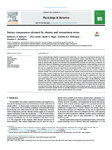Surface temperature elevated by chronic and intermittent stress
| dc.contributor.author | Herborn, Katherine | |
| dc.contributor.author | Jerem, P | |
| dc.contributor.author | Nager, RG | |
| dc.contributor.author | McKeegan, DEF | |
| dc.contributor.author | McCafferty, DJ | |
| dc.date.accessioned | 2019-01-22T09:35:54Z | |
| dc.date.issued | 2018-07 | |
| dc.identifier.issn | 0031-9384 | |
| dc.identifier.issn | 1873-507X | |
| dc.identifier.other | C | |
| dc.identifier.uri | http://hdl.handle.net/10026.1/13204 | |
| dc.description | publisher: Elsevier articletitle: Surface temperature elevated by chronic and intermittent stress journaltitle: Physiology & Behavior articlelink: http://dx.doi.org/10.1016/j.physbeh.2018.04.004 content_type: article copyright: © 2018 The Authors. Published by Elsevier Inc. | |
| dc.description.abstract |
Stress in homeothermic animals is associated with raised body core temperature and altered patterns of peripheral blood flow. During acute stress, peripheral vasoconstriction causes a short-lived drop in surface temperature that can be detected non-invasively using infrared thermography (IRT). Whether and how skin temperature changes under chronic stress, and hence the potential of IRT in chronic stress detection, is unknown. We explored the impact of withdrawing environmental enrichments and intermittent routine handling on long-term skin temperature in laying hens (Gallus gallus domesticus). Immediately following enrichment withdrawal, comb, face and eye temperature dropped, suggesting this was acutely stressful. In the 3 weeks that followed, barren-housed hens displayed behavioural markers of frustration. Whilst control birds, housed in enriched conditions, showed a decline over weeks in both comb temperature and baseline corticosterone levels, barren-housed hens had no change in comb temperature and an increase in corticosterone. By the trial end, comb temperature (but not corticosterone) was significantly higher in barren-housed hens. This change in parameters over time may reflect cumulative impacts of enrichment withdrawal in barren pens and/or, as hens were young and maturing, age-related changes in controls. Comb, face and eye temperature were also higher on days following routine handling, and comb temperature higher on other days in hens that were regularly handled for blood sampling than for a less intensive weighing protocol. Together, these data support comb, face and eye surface temperature increase as a long-term marker of stress exposure in laying hens. It is important to recognise that the strength and even direction of these effects may vary with thermoregulatory and energetic context. However, in laboratory and indoor-reared farm animals that live in carefully managed environments, IRT of the skin can potentially be used to non-invasively monitor chronic and intermittent stress exposure. | |
| dc.format.extent | 47-55 | |
| dc.format.medium | Print-Electronic | |
| dc.language | en | |
| dc.language.iso | en | |
| dc.publisher | Elsevier | |
| dc.subject | Body temperature | |
| dc.subject | chronic stress | |
| dc.subject | enrichment | |
| dc.subject | welfare | |
| dc.subject | Gallus gallus domesticus | |
| dc.subject | infrared thermography | |
| dc.title | Surface temperature elevated by chronic and intermittent stress | |
| dc.type | journal-article | |
| dc.type | Journal Article | |
| dc.type | Research Support, Non-U.S. Gov't | |
| plymouth.author-url | https://www.webofscience.com/api/gateway?GWVersion=2&SrcApp=PARTNER_APP&SrcAuth=LinksAMR&KeyUT=WOS:000432503900006&DestLinkType=FullRecord&DestApp=ALL_WOS&UsrCustomerID=11bb513d99f797142bcfeffcc58ea008 | |
| plymouth.volume | 191 | |
| plymouth.publication-status | Published | |
| plymouth.journal | Physiology and Behavior | |
| dc.identifier.doi | 10.1016/j.physbeh.2018.04.004 | |
| plymouth.organisational-group | /Plymouth | |
| plymouth.organisational-group | /Plymouth/Faculty of Science and Engineering | |
| plymouth.organisational-group | /Plymouth/Faculty of Science and Engineering/School of Biological and Marine Sciences | |
| plymouth.organisational-group | /Plymouth/REF 2021 Researchers by UoA | |
| plymouth.organisational-group | /Plymouth/REF 2021 Researchers by UoA/UoA04 Psychology, Psychiatry and Neuroscience | |
| plymouth.organisational-group | /Plymouth/Users by role | |
| plymouth.organisational-group | /Plymouth/Users by role/Academics | |
| dc.publisher.place | United States | |
| dcterms.dateAccepted | 2018-04-03 | |
| dc.rights.embargodate | 2019-2-6 | |
| dc.identifier.eissn | 1873-507X | |
| dc.rights.embargoperiod | Not known | |
| rioxxterms.versionofrecord | 10.1016/j.physbeh.2018.04.004 | |
| rioxxterms.licenseref.uri | http://www.rioxx.net/licenses/all-rights-reserved | |
| rioxxterms.licenseref.startdate | 2018-07 | |
| rioxxterms.type | Journal Article/Review |


